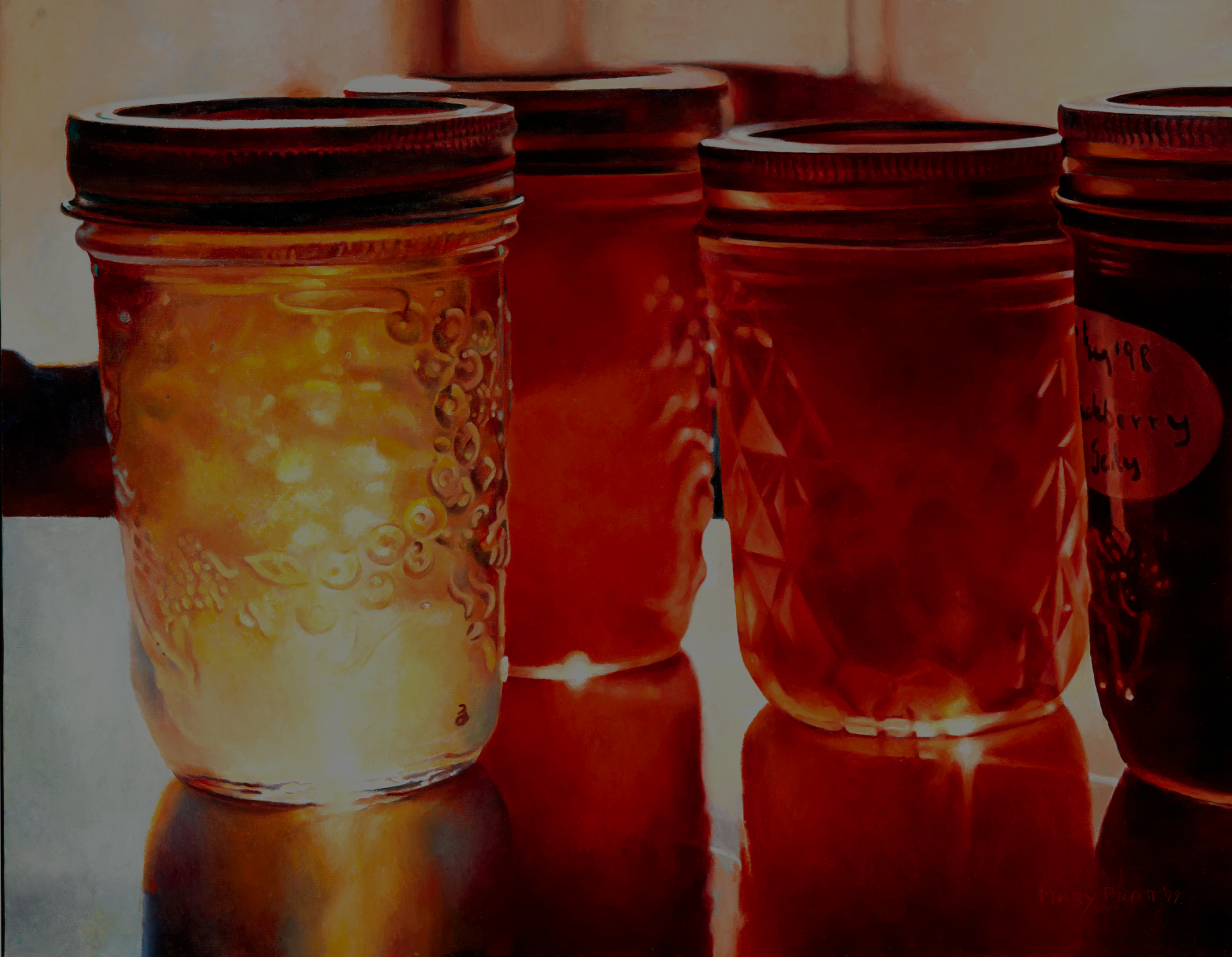Jelly Shelf
Mary Pratt
1999About the study guide
This easy to use guide has been thoughtfully created to assist teachers with their curriculum and lessons.
Download Study GuideAbout the study guide
This easy to use guide has been thoughtfully created to assist teachers with their curriculum and lessons.
Download Study GuideAbout the artwork:
This oil painting, done in the photorealism style, captures the fleeting moments when light passes through translucent jellies, setting the containers magically aglow.
Pratt painted jelly jars often, as she loved how the light passed through them. It reminded her of the stained-glass at church; it was almost a divine sort of beauty. As a visual symbol, jellies came to represent the interdependence of joy and sacrifice of motherhood and homemaking for Pratt. The painting’s sharp foreground and hazy, out-of-focus background mimics the way the lens of a camera sees versus our human eyes. Jelly Shelf was commemorated on a Canadian stamp in 2007.
About the artist:
Mary Frances West was born in Fredericton, N.B., in 1935. She has had a five-decade-long career, gaining national renown for her highly realistic still lifes, capturing charged moments from her daily life.
It was her mother who taught her to see a spectrum of colour. In 1953, Mary began her studies in fine arts at Mount Allison University, where her teachers included Lawren Phillips Harris and celebrated painter Alex Colville. Mount Allison is where Mary met fellow student Christopher Pratt, whom she would eventually marry and start a family with. Mary’s life shifted to domestic and caretaking responsibilities for their children and their home in Newfoundland. However, she felt called back to paint in daily moments, where light interplay captured her attention. Her process shifted, and she began to work from photographs. Mary has become a feminist icon because she made visible the often unseen and unrecognized labour of a woman caring for her family. She found moments of sensuality, magic, pain, and mortality within everyday tasks, like making dinner or canning preserves.
Please preview the short film and then share it with your students. Select one or two guiding questions that reflect your curriculum and can guide student research and inquiry connected to the artwork, artists, and the socio-cultural context in which it was created.
Guiding Provocations:
- What is significant about the success of Mary's work given the sociopolitical and historical conditions in which she lived and worked?
- How do these jelly jars and the work of the artist reflect larger social norms during her working life?
- How has society shifted between the time when this work was created and now?
- Which gender norms is Mary Pratt upholding, and which is she pushing against? How does this reflect contemporary experiences of women?
- What other symbols could be used to depict joy and sacrifice?
How did photographic technology inform the painting technique and creative processes? - Create a dance or drama piece or original musical composition inspired by the jelly jars.
- Create a dance drama or musical composition that brings focus to an everyday “domestic” scene from your life.
- How might the jelly jars serve as an ad campaign for a new product or restaurant?
- How might you document the process of jelly making, or other food processes, through images and depict the joy and sacrifice?
- Mary compares the light through the jars to a stained-glass church window. How might you present food in a way that represents a place that is sacred or special to you?
- Create a series of photographs where light is being refracted through a variety of objects.
- What does this image tell us about the properties of light? What does this image tell us about the properties of color?
- Depict a moment of everyday magic in one or more art forms.
- Examine how light is refracted through various substances.
- Use this image to inspire your writing. What happened before this moment where the light came through the jelly jars? What happened after?
